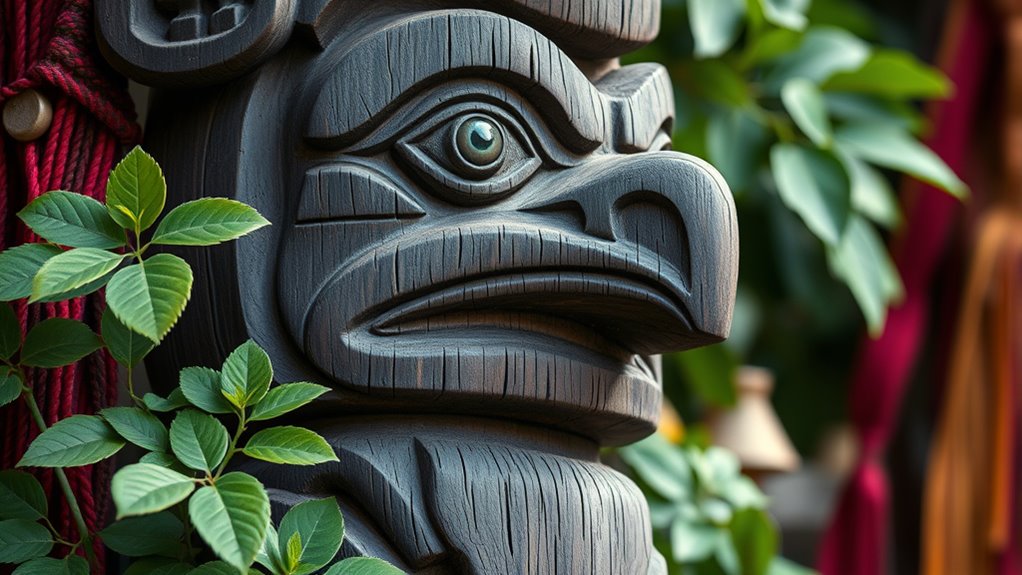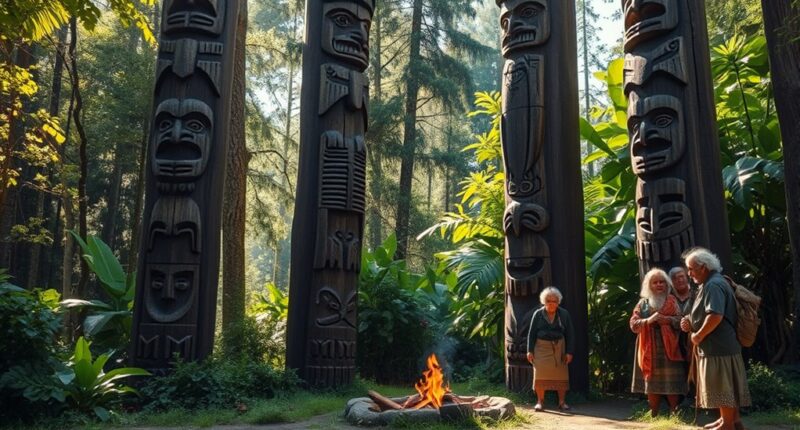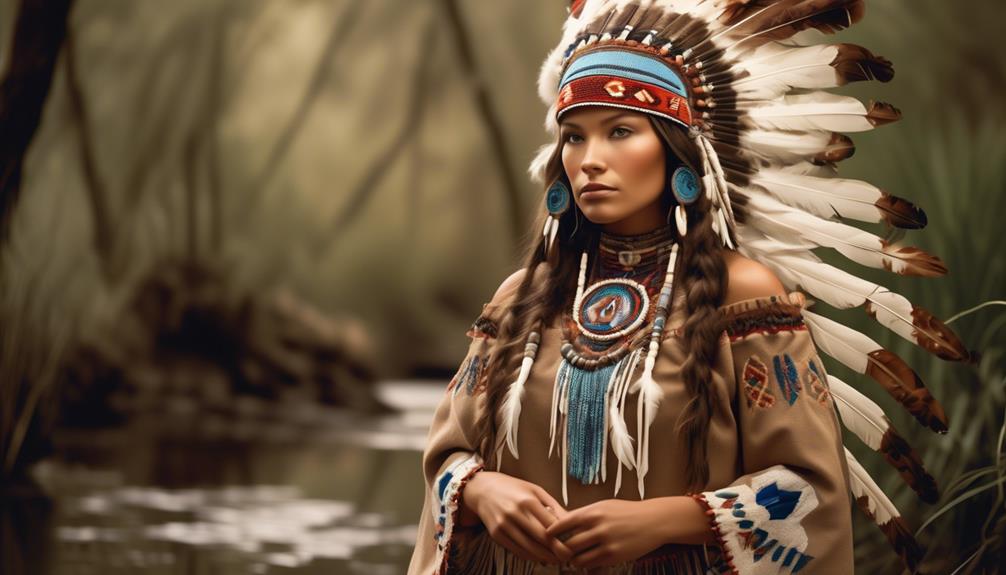Totems are more than symbols—they govern kinship and land connections that shape community life. They assign roles, influence marriage, and define social responsibilities, helping you understand your place within your clan and territory. Totems reflect your community’s relationship with nature and ancestors, fostering identity and cultural continuity. By respecting these rules, you can appreciate how land, kinship, and spirituality are intertwined. Keep exploring to discover how these traditions keep cultural diversity alive and strong.
Key Takeaways
- Totems serve as symbols of kinship, defining social roles, responsibilities, and relationships within communities.
- They establish rules for marriage, clan membership, and social conduct based on shared totemic affiliations.
- Totems connect communities to their land and ancestors, reinforcing territorial rights and cultural sovereignty.
- They embody qualities and stories that preserve cultural identity and pass traditions across generations.
- Totem-based kinship systems promote social cohesion and uphold the community’s spiritual and ecological worldview.

Have you ever wondered what totems truly represent? For many cultures, totems are more than just symbols; they embody deep spiritual connections and serve as essential links to ancestral heritage. The symbolic significance of a totem often reflects the qualities, stories, or natural elements that a community values most. By recognizing these symbols, you gain insight into how a group perceives itself and its place within the world. Totems act as living representations of identity, linking individuals to their kinship groups and providing a shared sense of purpose. This is why understanding their symbolic significance is fundamental—it helps preserve the traditions, beliefs, and values that define a culture. When you explore totems, you’re engaging in cultural preservation, ensuring that these meaningful practices and symbols are passed down through generations. They serve as a cultural anchor, reminding communities of their history and encouraging respect for nature and ancestors. Additionally, understanding the rules governing kinship and social organization reveals how these symbols influence societal roles and responsibilities.
As you explore the world of totems, you’ll notice how they govern kinship systems and social organization. Many indigenous groups, for example, assign totems to clans or family units, which then dictate social roles, marriage rules, and responsibilities. These systems create a structured framework that maintains social harmony and cohesion. When you understand these rules, you see how totems shape everyday life, guiding behavior and fostering a collective identity. They also reinforce the idea that humans are part of a larger ecological and spiritual network. By respecting and honoring totems, communities uphold their cultural integrity, ensuring that traditions are not lost over time. This ongoing process of cultural preservation helps sustain the unique worldview of each group, emphasizing the importance of kinship ties and spiritual kinship.
Furthermore, totems often serve as symbols of country or land, reinforcing a community’s connection to its territory. They embody a sense of belonging, representing the land itself and the ancestors who once inhabited it. Recognizing this relationship underscores the importance of respecting both the natural environment and cultural heritage. When you appreciate the role of totems in this context, you see how they act as guardians of cultural landscape and identity. Understanding these rules offers a window into how communities maintain their sovereignty and spiritual continuity. Ultimately, totems are more than artifacts—they are living symbols that preserve cultural memory, foster kinship bonds, and affirm a community’s rightful place within the natural world. By respecting and learning about them, you help support the ongoing preservation of cultural diversity across the globe. Recognizing the cultural significance of totems helps ensure that these traditions continue to thrive in modern times.
Frequently Asked Questions
How Do Totems Influence Everyday Social Interactions?
Totems influence your everyday social interactions through totem symbolism, which helps you identify with a group and reinforces shared values. When you recognize others’ totems, it strengthens social bonding and trust, making interactions more meaningful. These symbols remind you of your collective identity and responsibilities within your community. By respecting totem symbolism, you foster harmony and connection, ensuring that social relationships remain respectful and cohesive.
Are Totem Systems Unique to Specific Cultures?
Think of totem systems as cultural fingerprints—they’re unique to each society. For example, Indigenous Australians see their totems as spiritual symbols connecting them to nature and ancestors. These systems embody cultural symbolism and spiritual significance, shaping social roles and relationships. While many cultures have totemic beliefs, their specific symbols, stories, and rules are distinct, making each totem system a unique reflection of a community’s identity and spiritual worldview.
Can Totems Change Over Generations?
You might wonder if totems can change over generations. While genetic inheritance influences certain traits, totems often represent cultural continuity rather than biological ones. Cultures may adapt or reinterpret totems over time, reflecting shifting beliefs or social structures. This means totems can evolve as communities grow, merge, or face new circumstances, allowing the cultural significance to persist while the specific symbols or rules associated with them change across generations.
What Role Do Totems Play in Modern Society?
They say, “What’s old is new,” and this rings true today. In modern society, totems serve as powerful symbols of spiritual symbolism and environmental conservation. You can see this in how communities embrace totemic animals or plants to promote sustainability and cultural identity. These symbols connect you to nature and heritage, inspiring respect and responsibility for the environment. To get involved, learn about local totems and support conservation efforts rooted in these meaningful traditions.
How Are Totemic Beliefs Transmitted Across Communities?
You see that totemic beliefs are transmitted through cultural symbolism and stories shared within communities. You participate in rituals, ceremonies, and oral traditions that reinforce ancestral connections. These practices help pass down the significance of totems, ensuring that their meanings remain alive across generations. By engaging in community events and respecting cultural norms, you help preserve these beliefs and strengthen the bonds rooted in ancestral connections.
Conclusion
By understanding totems, you realize how they shape identity and kinship in Indigenous cultures. Nearly 80% of Aboriginal Australians see totems as essential to their spiritual and social life, highlighting their importance. This connection isn’t just tradition—it’s a way of respecting nature and community. When you grasp these rules, you see how totems preserve cultural knowledge and foster respect for the land and each other, ensuring these ancient practices continue thriving today.









